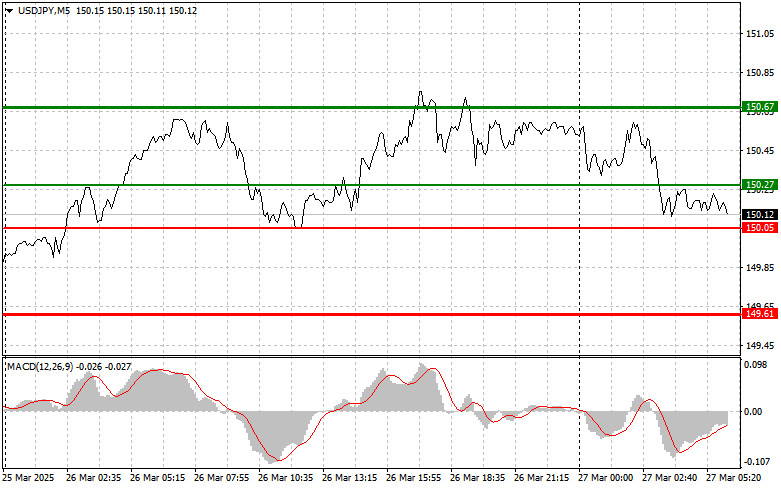

The first price test at 150.12 occurred when the MACD indicator moved significantly below the zero line, limiting the pair's downside potential. For this reason, I did not sell the dollar. The second test at 150.12, when the MACD was in the oversold zone, provided a basis for executing Buy Scenario #2. As a result, the pair rose by more than 60 pips, although we fell just short of the target level at 150.87.
The Japanese yen is gradually regaining ground against the U.S. dollar. Despite recent statements from Bank of Japan Governor Kazuo Ueda, who said he intends to keep interest rates unchanged at the next monetary policy meeting, the likelihood of a rate hike later this year remains quite high.
Today's report on Japan's Leading Economic Index came in better than economists had expected, which led to a decline in USD/JPY. Investors interpreted this as a sign of strengthening the Japanese economy, increasing demand for the yen. This highlights how sensitive the forex market is to macroeconomic data and its influence on investor sentiment. The drop in USD/JPY may also reflect a reassessment of future U.S. Federal Reserve policy risks.
For intraday strategy, I will focus primarily on implementing Scenarios #1 and #2.
Scenario #1: I plan to buy USD/JPY today at the entry point around 150.27 (green line on the chart) with a target of 150.67 (thicker green line on the chart). Around 150.67, I plan to exit long positions and open short positions in the opposite direction (expecting a pullback of 30–35 pips from the level). Important: Before buying, make sure the MACD indicator is above the zero line and just starting to rise from it.
Scenario #2: I also plan to buy USD/JPY if the price tests 150.05 twice in a row while the MACD is in the oversold zone. This would limit the downside potential and could trigger a reversal to the upside. Targets: 150.27 and 150.67.
Scenario #1: I plan to sell USD/JPY only after a breakout below 150.05 (red line on the chart), which could lead to a sharp decline. The key target for sellers will be 149.61, where I plan to exit shorts and open immediate longs (expecting a rebound of 20–25 pips from the level). Important: Before selling, ensure the MACD indicator is below the zero line and just starting to fall from it.
Scenario #2: I also plan to sell USD/JPY today if the price tests 150.27 twice in a row while the MACD is in the overbought zone. This would limit the upside potential and may lead to a reversal downward. Targets: 150.05 and 149.61.


QUICK LINKS